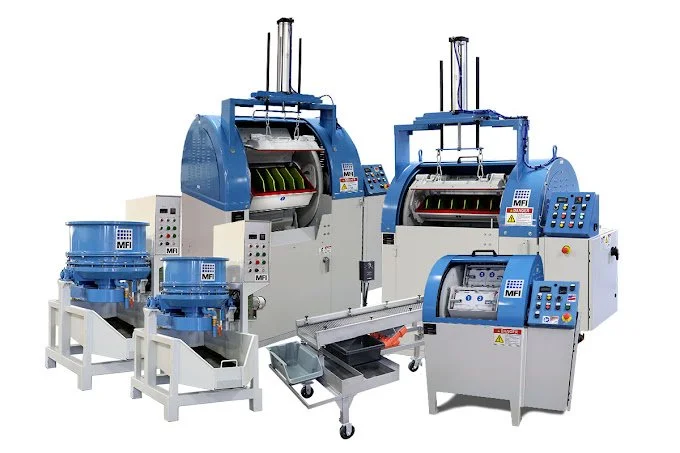Mass finishing and vibratory finishing are widely used methods in the surface finishing industry to achieve desired surface qualities and enhance the appearance of parts and components. These processes utilize specialized equipment to perform high-quality surface finishing operations.
Mass Finishing
Mass finishing involves the simultaneous treatment of multiple workpieces within a vibratory tumbler or barrel, allowing for efficient processing and consistent results. The workpieces are placed together with abrasive media, compounds, and water (or other liquid solutions) in the equipment. The vibratory action of the machine causes the media to interact with the workpieces, resulting in various surface finishing effects such as deburring, edge radiusing, surface smoothing, and polishing.
Key Features and Benefits of Mass Finishing:
Versatility: Mass finishing can be applied to a wide range of materials, including metals, plastics, ceramics, and composites.
Uniformity: The process ensures consistent results across all treated parts, providing a uniform finish and improving product aesthetics.
Deburring and Edge Radiusing: Mass finishing effectively removes burrs and sharp edges, enhancing part safety and functionality.
Surface Smoothing and Polishing: The abrasive media in mass finishing equipment can refine surface roughness, improve texture, and create a polished appearance.
Time and Cost Efficiency: The batch processing capability of mass finishing allows for efficient treatment of multiple parts simultaneously, reducing processing time and costs.
Vibratory Finishing
Vibratory finishing is a subset of mass finishing that specifically utilizes vibratory bowls or tubs to achieve surface improvement. The equipment consists of a vibratory motor that imparts controlled vibrations to the bowl, causing the media, workpieces, and finishing compounds to interact. This action facilitates deburring, edge radiusing, surface refinement, and polishing.
Key Features and Benefits of Vibratory Finishing:
Gentle Processing: Vibratory finishing offers a gentle treatment method that is suitable for delicate or fragile parts that require careful handling.
Complex Geometries: The vibrating motion allows the media to reach intricate part geometries, ensuring uniform surface finishing in hard-to-reach areas.
Consistent Results: Vibratory finishing provides predictable and repeatable results, making it ideal for applications that demand precise finishing outcomes.
Enhanced Efficiency: The continuous movement of the media in the vibratory equipment ensures efficient cutting action and surface refinement.
Customizability: The process can be tailored by selecting the appropriate media, compounds, and processing parameters to achieve specific finishing requirements
Mass Finishing and Vibratory Finishing
Barrel Finishing
Barrel finishing is a type of mass finishing process that utilizes a rotating barrel filled with workpieces, abrasive media, compounds, and liquid solutions. The barrel's rotational motion causes the contents to tumble, facilitating surface finishing operations. Barrel finishing is particularly effective for small to medium-sized parts and components.
Key Features and Benefits of Barrel Finishing:
Batch Processing: Barrel finishing enables the treatment of a large number of workpieces in a single operation, making it a highly efficient and time-saving method.
Deburring and Edge Radiusing: The tumbling action in the barrel helps to remove burrs, sharp edges, and irregularities from the workpieces, improving their functionality and safety.
Surface Smoothing and Polishing: The abrasive media in the barrel interacts with the workpieces, resulting in surface refinement, smoothing, and polishing. This enhances the overall appearance and texture of the finished parts.
Part-on-Part Finishing: Barrel finishing allows for part-on-part interaction, enabling a cascading effect that helps achieve consistent surface finishing across all the workpieces.
Uniformity: The tumbling action and constant contact between the workpieces and media in the barrel promote uniform surface finishing, ensuring consistent results throughout the batch.
Media and Compounds in Surface Finishing
In mass finishing, vibratory finishing, and barrel finishing processes, the selection of appropriate media and compounds is crucial to achieve desired surface finishing results. These consumables play a significant role in removing burrs, polishing surfaces, and achieving the desired finish. Here are the commonly used types of media and compounds:
Media Types:
Ceramic Media: Ceramic media is a versatile option suitable for deburring, polishing, and general surface improvement. It is available in various shapes, sizes, and compositions to accommodate different finishing requirements.
Plastic Media: Plastic media is often used for gentle surface treatment, especially for delicate parts or components that require careful handling. It is available in different shapes and sizes to achieve specific surface finishing effects.
Steel Media: Steel media, including steel balls, pins, and diagonals, is commonly used for heavy cutting, aggressive deburring, and radiusing applications. It is highly durable and can withstand demanding surface finishing operations.
Organic Media: Organic media, such as corncob or walnut shell media, is a natural and environmentally friendly option used for light deburring, polishing, and surface cleaning. It is gentle on delicate parts and is often employed in industries where biodegradable materials are preferred.
Compounds:
Cleaning Compounds: Cleaning compounds are used to remove oils, greases, and other contaminants from the workpieces. They aid in the overall cleaning and degreasing process, ensuring a pristine surface for subsequent finishing steps.
Burnishing Compounds: Burnishing compounds are formulated to enhance the surface brightness and achieve a mirror-like shine on the workpieces. These compounds contain additives that promote metal flow and increase surface luster during the finishing process.
Rust Inhibitors: Rust inhibitors or corrosion inhibitors are compounds used to protect the workpieces from rust or corrosion during and after the finishing process. They create a protective barrier on the surface, preserving the integrity of the finished parts.
Drying Agents: Drying agents are added to the finishing process to aid in the quick drying of the workpieces, ensuring the removal of any residual liquid and preventing water spots or staining.
Selecting the appropriate media and compounds depends on the specific requirements of the surface finishing application. Factors such as material type, desired finish, part geometry, and process parameters influence the choice of media and compounds to achieve optimal results.





